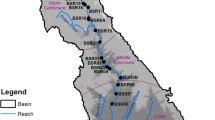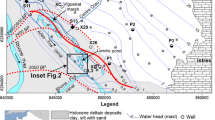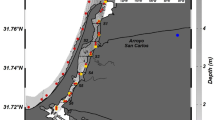Abstract
A case study was carried out with the aim to practically test whether estimates of groundwater discharge rates into dredging lakes can be made via an uncomplicated and straightforward technique using radon-222 as naturally-occurring groundwater tracer. Lake Ammelshainer See, a dredging, seepage lake, approximately 25 km east of Leipzig, Germany, was chosen as the investigation site. In order to evaluate changes in the spatial and temporal radon-222 patterns in the lake during different stages of stratification, sampling campaigns were conducted in April 2007 (well mixed stage) and in May 2007 (thermal stratification stage). Groundwater flow estimates were made using a radon mass balance approach accounting for all radon fluxes into and out of the lake and assuming steady-state conditions with respect to these radon fluxes. Once all positive and negative radon fluxes related to the lake water volume were determined, groundwater discharge was estimated by using the advective radon input and the radon activity concentration of the pore water as key parameters. The results showed that in case of a lake with a size and shape of Lake Ammelshainer See (530,000m2) reasonable groundwater discharge estimates can be made by collection and analyzing just a few water samples and a few samples from the sediment layer.




Similar content being viewed by others
References
Burnett WC, Santos IR, Weinstein Y, Swarzenski PW, Herut B (2007) Remaining uncertainties in the use of Rn-222 as a quantitative tracer of submarine groundwater discharge. In: Sanford W, Langevin C, Polemio M, Povinec P (eds) A new focus on groundwater–seawater interactions. IAHS Publications 312, Perugia, Italy, pp 109–118
Burnett W, Cable JE, Corbett D (2003) Radon tracing of submarine groundwater discharge in coastal environments. In: Taniguchi M, Wang K, Gamo T (eds) Land and marine hydrogeology, Elsevier, Amsterdam, pp 25–43
Cable JE, Burnett WC, Chanton JP, Weatherly GL (1996) Estimating groundwater discharge into the northeastern Gulf of Mexico using radon-222. Earth Planet Sci Lett 144:591–604
Cook PG, Solomon DK, Plummer LN, Busenberg E, Schiff SL (1995) Chlorofluorocarbons as tracers of groundwater transport processes in a shallow, silty sand aquifer. Water Resour Res 31:425–434
Corbett DR, Burnett WC, Cable PH, Clark SB (1997) Radon tracing of groundwater input into Par pond, Savannah river site. J Hydrol 203:209–227
Corbett DR, Burnett WC, Cable PH, Clark SB (1998) A multiple approach to the determination of radon fluxes from sediments. J Radioanal Nucl Chem 236:247–252
Corbett DR, Dillon K, Burnett WC, Chanton JP (2000) Estimating the groundwater contribution into Florida Bay via natural tracers 222Rn and CH4. Limnol Oceanogr 45:1546–1557
Eissmann L, Litt T (1994) Klassische Quartärfolge Mitteldeutschlands von der Elsterzeit bis zum Holozän unter besonderer Berücksichtigung der Stratigraphie, Paläoökologie und Vorgeschichte. Altenburg Naturwissenschaftliche Forsch 7:250–356
Gibson JJ, Prepas EE, McEachern P (2002) Quantitative comparison of lake throughflow, residency, and catchment runoff using stable isotopes: modelling and results from a regional survey of Boreal lakes. J Hydrol 262:128–144
Gooddy DC, Darling WG, Abesser C, Lapworth DJ (2006) Using chlorofluorocarbons (CFCs) and sulphur hexafluoride (SF6) to characterise groundwater movement and residence time in a lowland Chalk catchment. J Hydrol 330:44–52
Haferkorn U, Müller K, Mellentin U, Fahl J (2003) Möglichkeiten und Grenzen der Stofftransportmodellierung (Nitrat) am Beispiel des Parthegebietes. UFZ-Bericht 14
Hoehn E, von Gunten HR (1989) Radon in groundwater: a tool to assess infiltration from surface waters to aquifers. Water Resour Res 25:1795–1803
Kluge T, Ilmberger J, von Rohden C, Aeschbach-Hertig W (2007) Tracing and quantifying groundwater inflow into lakes using a simple method for radon-222 analysis. Hydrol Earth Syst Sci 11:1621–1631
Lee JM, Kim G (2006) A simple and rapid method for analyzing radon in coastal and ground waters using a radon-in-air monitor. J Environ Radioact 89:219–228
Macintyre S, Wanninkhof R, Chanton JP (1995) Trace gas exchange across the air-water interface in freshwater and coastal marine environments. In: Matson PA, Harriss RC (eds) Methods in ecology—biogenic trace gases: measuring emissions from soil and water. Blackwell, Cambridge, pp 52–97
Mueller M, Sames D, Mansel H (2003) PCGEOFIM–A finite Volume Model for More? In: Poeter E, Zheng C, Hill M, Doherty J (eds) MODFLOW and more 2003: understanding through modelling. Conference proceedings
Schmidt A, Schubert M (2007) Using Radon-222 for tracing groundwater discharge into an open-pit lignite mining lake: a case study. Isotopes Environ Health Stud 43:387–400
Schubert M, Bürkin W, Peña P, Lopez A, Balcázar M (2006) On-site determination of the radon concentration in water samples: methodical background and results from laboratory studies and a field-scale test. Radiat Meas 41:492–497
Stringer C (2004) Assessment of groundwater discharge to Lake Barco via radon tracing. Master Thesis, Department of Oceanography, Florida State University
Stringer C, Burnett WC (2004) Sample bottle design improvements for radon emanation analysis of natural waters. Health Phys 87:642–646
Tuccimei P, Salvati R, Capelli G, Delitala MC, Primavera P (2005) Groundwater fluxes into a submerged sinkhole area, Central Italy, using radon and water chemistry. Appl Geochem 20:1831–1847
Yehdegho B, Rozanski K, Zojer H, Stichler W (1997) Interaction of dredging lakes with the adjacent groundwater field: an isotope study. J Hydrol 192:247–270
Acknowledgments
We thank Stefanie Härtel, Daniel Geppert, Nico Meye, and Nadine Zimmer for their essential support in field and laboratory work during this study. The thoughtful and valuable comments by Richard Peterson, Isaac Santos, and Natasha Dimova to a draft version of this manuscript are gratefully acknowledged. Axel Schmidt holds a scholarship of the Studienstiftung des deutschen Volkes.
Author information
Authors and Affiliations
Corresponding author
Rights and permissions
About this article
Cite this article
Schmidt, A., Stringer, C.E., Haferkorn, U. et al. Quantification of groundwater discharge into lakes using radon-222 as naturally occurring tracer. Environ Geol 56, 855–863 (2009). https://doi.org/10.1007/s00254-008-1186-3
Received:
Accepted:
Published:
Issue Date:
DOI: https://doi.org/10.1007/s00254-008-1186-3




